The world of vintage sewing machines rarely offers a good scandal. Mid-century Morse sewing machines dish out all the mystery you could hope for! If you own a mystery Morse you’re probably curious to find out all about Morse sewing machine models, history, and value!
Philip Morse founded the Morse company in 1948 with the help of his wife. He imported a large number of Japanese sewing machines from various manufacturers. The company came under scrutiny from the Fair Trade Commission when it claimed the Japanese sewing machines were American-made as a marketing ploy.
In this article, you will find out all there is to know about the Morse sewing machine scandal. You will learn the names and key characteristics of the most popular Morse models. Finally, you will discover how much Morse sewing machines sell for today!
Morse Sewing Machine History
In 1948, an American named Philip Sidney Morse founded a company with himself as the president and his wife as the treasurer. At first, The Morse company seems to have served as a distributor of various Japanese products. Morse brought the products to the States and then passed them on to several other American companies. They used a company called Mercury, also founded by Philip Morse, to import these items.
The small family-run company achieved temporary success selling Japanese-made sewing machines. Mercury imported the machines, and Morse marketed and sold them. By itself, selling Japanese-made machines was nothing new.
In the post-WWII era, the Japanese sewing machine industry exploded. This period launched successful companies like Janome. At the time, though, many of these companies did not have any brand recognition yet.
For this reason, lots of them sold sewing machines to American companies. The American companies re-branded or “badged” the Japanese sewing machine with an American logo.
Big-name brands like White and Kenmore used lots of Japanese models. That said, these machines offered clear provenance. Most of them have serial numbers that begin with the letters “JA” to indicate that the machine was made in Japan.
On top of that, you can trace a paperwork trail to find out exactly what Japanese company sold the model to the American company, at least most of the time.
Morse did not do this. Instead, he used Mercury, the importing company, to obfuscate the fact that the machines had come from overseas. According to the charges, it seems that Mercury and Morse removed any identifying features that marked the models as “made in Japan.”
Then Morse proceeded to use advertisements that claimed Morse sewing machines were American-made!
You may find yourself scratching your head, wondering why this is a big deal. Well, making false claims about a product is still a big deal today! The Federal Trade Commission caught wind of this and issued a ruling against Morse in 1955.
The ruling noted that Morse and Mercury had violated the Federal Trade Commission Act. The product Morse sold did not display its country of origin. The company had also used marketing language that claimed Morse had manufactured the sewing machines.
No records exist today indicating exactly how many “Morse” sewing machines were sold before this ruling came down. You can still find easy access to vintage models, though, which means a good number must have flooded the market at the time!
By today’s standards, many Japanese models outpaced or improved upon the American models sold at the time. However, American consumers tended to value “American-made” products. This bias lasted well after the end of WWII.
For this reason, It seems like Morse made false claims to make more sales!
Who Made Morse Sewing Machines?
It’s difficult to discover who made most Morse sewing machines because Mercury and Morse hid the origins of these machines. Based on evidence such as design, the patents issued, and the limited records available, it is possible to narrow down the choices. Sewing machine experts agree that the Japanese companies Pine, Toyota, and Brother made at least some of the Morse models.
Here’s the thing, though. You will not find any records on the American side of the importing transaction. Mercury removed any labels or markings before Morse sold the machines. No one knows what happened to the company following the scandal, too!
Plus, the Japanese companies that sold mass-produced machines to the States understandably do not want to make a big deal out of this era. Many of these companies went on to become prominent names in the sewing world. They do not want to advertise a time when they weren’t successful enough to sell items under their own brands yet.
To further muddy the waters, some sewing machine experts think that Morse had a tiny bit of veracity behind his claims. He may have imported only parts of the Japanese sewing machines and then used American-made wiring to complete them!
This option seems unlikely. Morse, the company did not own any manufacturing facilities. But who knows?
The bottom line is that no records exist to solve this mystery. If you have a mystery Morse machine, you will probably never know who made it!
What Happened to Morse Sewing Machines?
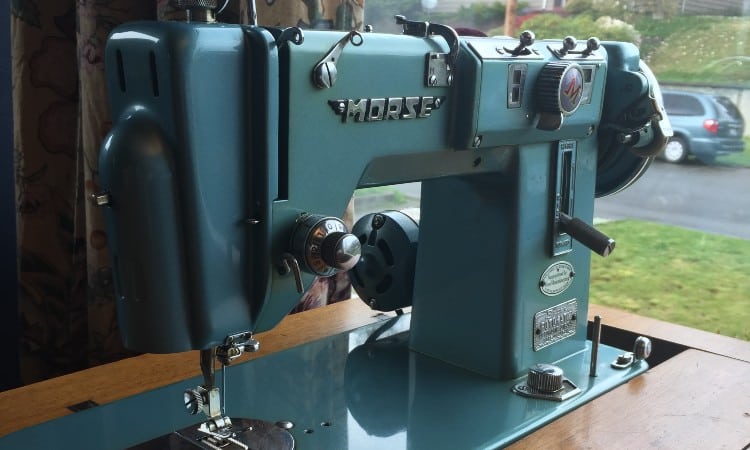
Source (1)
The Morse and Mercury companies disappeared from all records shortly after the trouble with the FCC. Morse does not appear to have filed for bankruptcy, and several popular Morse models continued to sell at least until 1960.
That said, the company most likely went out of business after the FCC ruling. The government may even have forcibly shut down Morse and Mercury, though once again, you will not find any clear record of this!
Philip Morse and his wife must have made quite a bit of money off the illegal venture, so it would be interesting to know what happened to them after this! Unfortunately, they seem to have vanished into the mists of time.
Where are Morse Sewing Machines Made?
The Morse company does not exist today. You cannot buy a modern Morse machine. Plenty of vintage Morse models still sell on eBay and through other antique sellers, though!
If you own a vintage Morse model and you want to know where it was made, good luck to you! Based on the language the FCC used, you can be pretty certain your machine was made in Japan. You may never find out which Japanese company actually manufactured it, though.
Like any good conman or magician, Philip Morse disappeared, leaving his audience with the outcome of his trick but no idea how he made it work!
Morse Sewing Machine Models
Though the Morse company only existed for a few years, it sold several successful models. These machines continued to circulate in the mid-century market through the 1960s. These models included the Fotomatic, the Super Dial, and the Ambassador.
Morse machines have a square, boxy look and come in painted steel cases. The color schemes look rather Boba-Fett-like for any Star Wars fans out there!
Morse Zigzag Fotomatic
Morse promoted several different models of the Fotomatic. These included the Super Fotomatic and Fotomatic models one through four.
These models came in several color schemes, including a dull blue and two-tone green and blue color scheme. A few of them may have the word “Toyota” stamped into the metal on the bottom of the machine, which offers a rare clue into the actual manufacturer!
The true reason the Fotomatic series sold so well, though, was its innovative stitch display. A small window showed an actual picture of what a decorative stitch would look like!
Today, this may seem boring. After all, we have sewing machines that operate like 3D printers operated by complex computer software available to us! In the 1940s and 50s, though, this simple innovation rocketed the Fotomatic to extreme popularity!
Some Fotomatic models also offered a cute little pincushion attached to the body of the machine. Plus, of course, they provided zigzag stitching, still a novelty at the time!
Finally, some “Fotomatic” models also have more specific model numbers, such as morse 4100 and Morse 4700. This may help you track down information about your sewing machine if you have a model that falls into those categories!
Morse Super Dial
Like all Morse sewing machines, the Super Dial is a boxy, all-metal machine with hefty and durable parts. The Super Dial often comes in a dusty, steely blue with a large chrome logo displayed on the body of the machine. You may also find some Super Dial models in a very cute pink or magenta shade!
Unlike the Fotomatic, the Super Dial offers a straight stitch option. Though it doesn’t have as many features as lots of sewing machines from this era, it does provide precision stitching with such well-crafted parts that many of these models continue to sew well today, seventy years later!
The Ambassador
The Ambassador models hit the market sometime around 1950 when Morse trademarked the name “Ambassador.” These models usually feature a two-tone color scheme of pale pink and cream or turquoise and cream. They have a boxy shape and extremely heavy, solid workmanship.
The Ambassador models use cams, sort of like small discs with notches around the outer rim. When staked inside the needle bar mechanism, these cams divert the path of the needle, causing it to create fancy stitching patterns. Cams typically preceded fully automatic stitching in sewing machines giving you another indication of how to date this model.
There are no records on how many Ambassador models Morse sold, but this model, in particular, pops up for sale quite often today, indicating that it must have sold successfully in the 1950s!
How Old is a Morse Sewing Machine?
Morse sewing machine ages range from 60 to 70 years old today. While it’s tricky to apply a specific date to most Morse models, you can easily get a general idea of the age of any Morse machine because they were only sold from 1948 through the 1950s, when the company disappeared.
The FCC issued its ruling in 1955. Records do not show whether or not Morse continued to sell machines for a while after this. By 1960, the company seemed to have vanished.
If you do the math, that means that today, a Morse sewing machine must be roughly 60 to 73 years old!
Every sewing machine originally comes with a user’s manual. Some of the Morse manuals include the date of sale as well. This doesn’t tell you the production date necessarily, but it can help narrow down the age of the machine.
You can also examine an individual model to see what kind of features it offers. For example, a model that uses cams for a zigzag stitch probably predates an automated stitching model.
Morse Sewing Machine Serial Number
Every Morse sewing machine has a model number and a unique serial number engraved or stamped somewhere. You can often find the serial number either near the electrical wire or underneath the machine’s body.
Finding the serial number may lead you to more information about your machine. That said, it isn’t as helpful a resource as it could be because, to date, no one has compiled a list of Morse serial numbers online for easy reference.
This means that you cannot easily match your Morse serial number to a particular model, or easily date the model, either!
What you can do is Google the serial number and model number and see if you can find any results about your particular model of Morse sewing machine.
You can also join the extremely enthusiastic online community of Morse sewing machine users. You can find several sewing forums dedicated to Morse sewing machine users. You can even find a Facebook group just for morse sewing machine users!
Morse Sewing Machine Manual
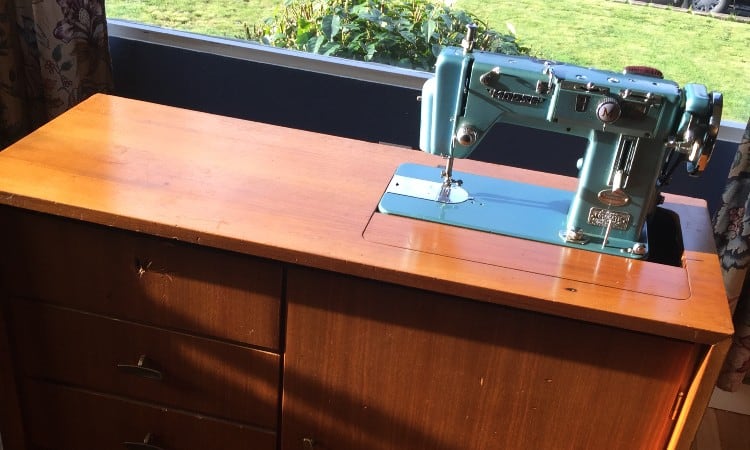
Source (1)
Every Morse sewing machine originally came with a helpful pamphlet called a user’s manual describing the various parts and functions of the machine. This essential document will also help you as learn how to use your vintage Morse machine!
If your vintage Morse machine did not come with a manual, though, you may need to do some digging to find one.
You can often find physical copies of old sewing machine manuals for sale on eBay and Amazon. If you would like a faster option, you can buy one to download from websites like this. These usually cost anywhere from five to ten dollars, but you don’t have to pay a shipping fee for a download!
If you do not want to buy the manual, you can seek out the help of fellow sewers through online forums or Facebook groups. Vintage Morse sewing machines have a wide following because of their extremely heavy weight and durability. This means that lots of other home sewers may have copies of the manual sitting around at home, and one of them will likely offer to email you a copy of the manual!
Make sure you find or buy the specific manual for your Morse model. If you have a Fotomatic, the manual for an Ambassador model will not give the specific instructions you need! Also, simply searching for the “Morse sewing machine zigzag manual” will not give you precise results. Make sure you get the manual with the same model number as your machine!
Morse Sewing Machine Parts
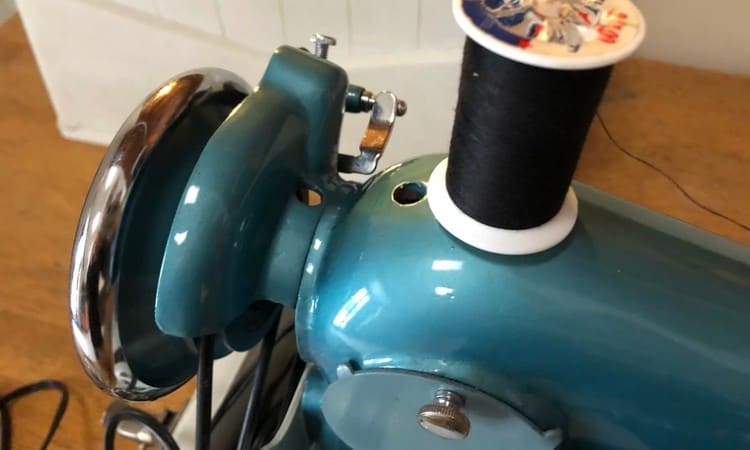
You may need Morse sewing parts to fix an old or damaged piece of the machine or to add a unique attachment. Some Morse machines offer unique parts, such as a special zigzag needle plate, so you need to always make sure you buy parts designed specifically for your Morse model.
Before you dive into buying sewing machine parts, though, consider whether or not you should take your Morse sewing machine to a certified technician.
Your seventy-year-old sewing machine may just need a good cleaning and an easy light replacement. On the other hand, it could have worn-out wiring or a clogged motor! That kind of repair probably requires professional help unless you have a lot of confidence in your small-motor-repair abilities.
Flaking rubber covers on wires or just loose wiring is one of the most common issues with old sewing machines. If the machine did not receive good care during its long life, it may also have dust and lint jammed into all kinds of places, preventing mechanisms from turning properly.
Vintage sewing machines have fairly basic mechanical functions, but they do have many small, intricate parts inside!
If you do want to try your hand at replacing parts, the good news is that you can easily find Morse sewing machine parts for sale online. Etsy and eBay offer the easiest, searchable method for finding a specific part. You can also find websites dedicated just to selling vintage sewing machine parts, or even go to a thrift store to find another Morse sewing machine you can plunder for spare parts!
Value of Morse Sewing Machines
Vintage Morse sewing machines typically sell for anywhere from $50-$200 today, though you can often find them on the lower end of that price range. Despite the Morse company scandal, Morse machines continued to sell well back in the day and they remain popular today.
That said, vintage sewing machines do not often have a high monetary value. Even really famous brands like Singer usually sell for around $200! Aside from a few rare collectible models, you will not make much money from selling old sewing machines.
Morse machines do not have collectible status. They do, however, have an excellent reputation for durability. These super-heavy machines will hold up for decades and decades of use!
Today, Morse sewing machines don’t cost a lot and you won’t resell a Morse to turn a big profit. But if you want a solid, precise sewing machine for actual use, look no further!
Are Morse sewing machines good? In terms of actual sewing abilities, yes! They offer solid metal construction, precise engineering, and reliability. You can really count on these big, heavy machines!
Lots of modern sewers agree. Sewers value Morse models because these machines can sew through thick material and last a lot longer than many modern machines. This is why you will find so many online forums and groups dedicated to discussing how to buy, repair, and use Morse sewing machines!
Conclusion
Morse sewing machines have a unique history because the Morse company only lasted a few years before floundering under a massive scandal. The FCC discovered that Morse had not actually manufactured the sewing machines it claimed to have made! Instead, Morse had imported the machines from Japan for sale in the United States.
Of course, Morse sewing machines work just fine despite the scandal! Many home sewers today value these vintage machines for their durable metal parts and reliability.
Do you own a Morse sewing machine? What do you like most about it? Leave a comment below to let us know!
(1) Shared under a Creative Commons (BY-SA) license
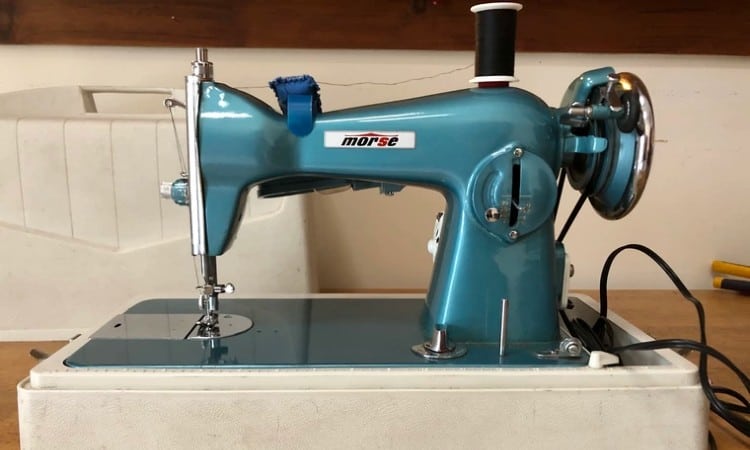
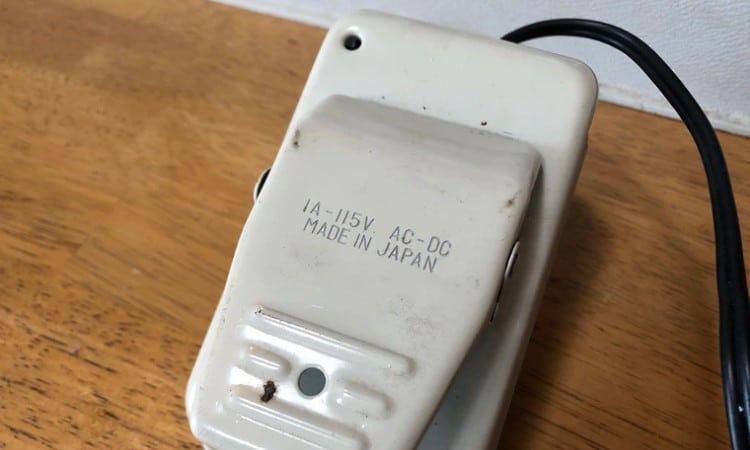
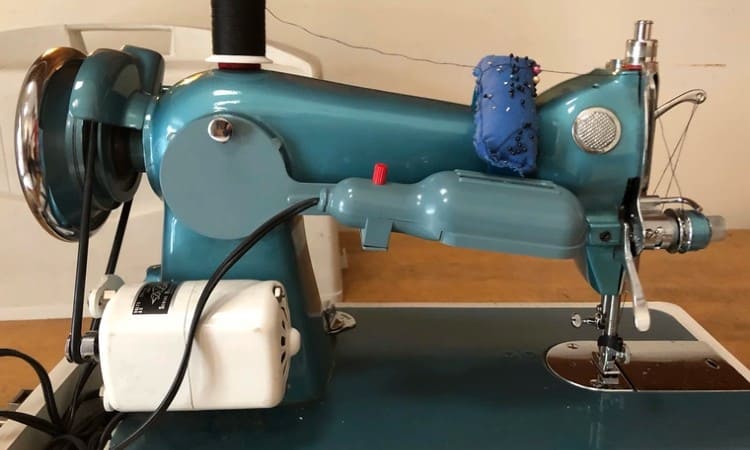
Jeanne Ringland
Tuesday 9th of May 2023
I recently bought a Morse 300 BL Deluxe in a cabinet, and I am cleaning up the old sewing machine oil that has turned to varnish. This is a pretty machine, and it weighs a ton. It has a blue metallic finish, and a gorgeous Art Deco head piece. There is no mark of origin, alas, but your article puts it squarely in the 1950s, and probably earlier than the Foto-Matic. It looks kind of like a Brother I own, but some features that do not look like a Brother.
Linda Rave
Thursday 16th of February 2023
I was given a Morse Apollo 6200 by a friend who wanted to learn to sew but not badly enough to practice. She bought it 2nd hand and took it to a very reputable repair shop so it runs great. When she gave up sewing she gave her Morse to me. I have been Sears Kenmore person since I got my first machine in 1970’s but this Morse sure runs great and I find I use it more and more. Those older machines are so much more sturdy than plastic ones. Obviously I can’t use it for all applications but it won’t break like my Brother did when it went to the floor as my ankle was wrapped around the cord as I got up to answer the door either. I love sewing!